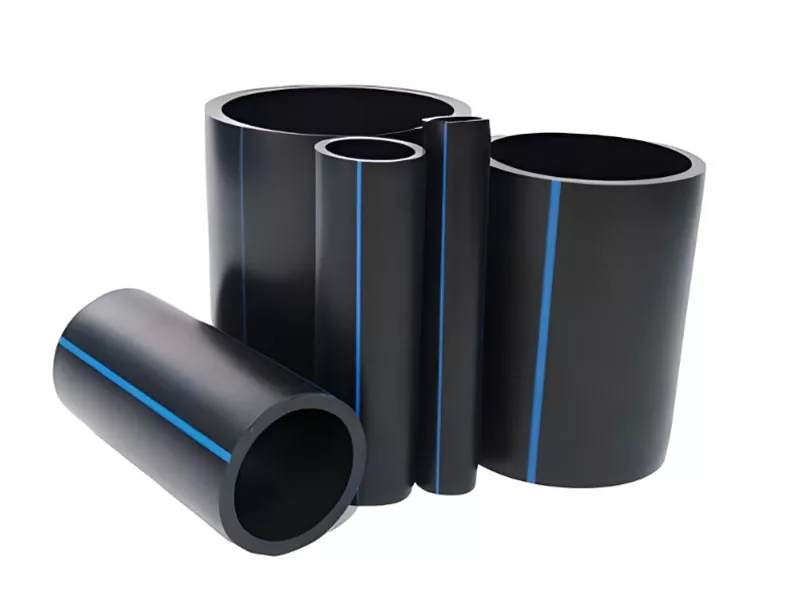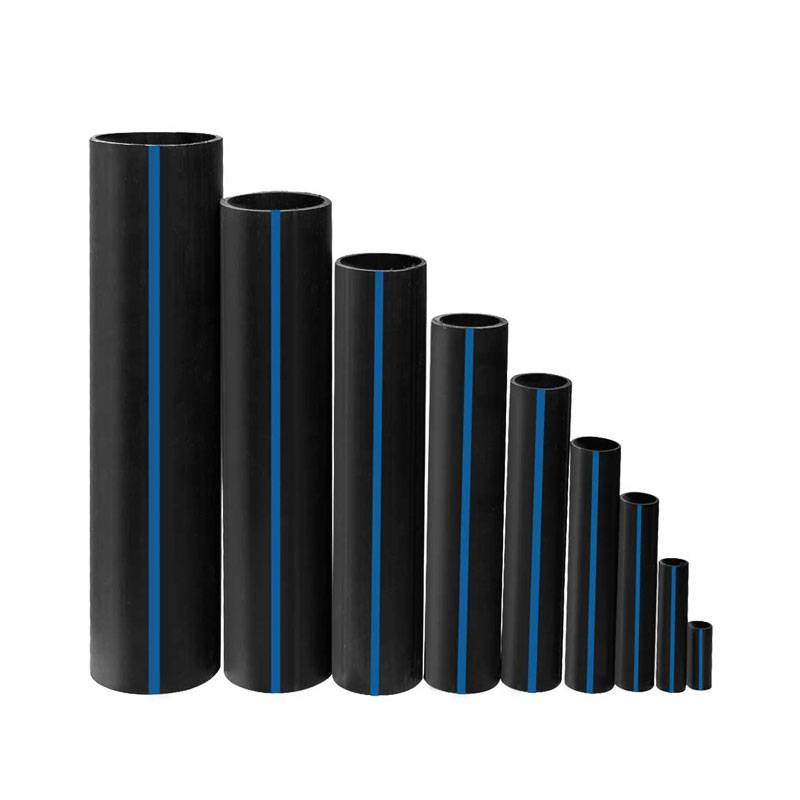Check Out the Manufacturing Process Behind High-Quality HDPE Pipe and Its Applications
The production process of high-grade HDPE pipes is elaborate and methodical. It starts with the choice of basic materials that enhance efficiency. Following this, ethylene undertakes polymerization to create material, which is then formed via extrusion. Quality assurance is paramount, making sure that the end product meets strict criteria. However, the journey of HDPE pipelines does not end with production. Their applications throughout various industries expose a wider importance worth analyzing.
Comprehending HDPE: Features and Advantages

High-density polyethylene (HDPE) is a versatile polycarbonate recognized for its resilience and resistance to various ecological elements. This product shows exceptional tensile strength, making it appropriate for demanding applications. Its low-density structure adds to a lightweight item, assisting in ease of dealing with and installment. HDPE additionally showcases exceptional resistance to chemicals, which minimizes destruction when exposed to harsh materials.
The material's reduced wetness absorption even more improves its long life, making it excellent for use in pipes and storage containers. Furthermore, HDPE is immune to ultraviolet (UV) radiation, making certain that products keep their stability even when revealed to sunshine. Its versatility enables for the production of elaborate forms without jeopardizing strength. The eco-friendly nature of HDPE, frequently originated from recycled products, adds to its allure, promoting sustainable practices in manufacturing. In general, these residential properties and benefits make HDPE a favored option for various industrial and consumer applications.
Basic Material Selection for HDPE Manufacturing
The choice of resources for HDPE manufacturing is important to validate the end product meets the desired specifications and top quality requirements. High-density polyethylene (HDPE) is primarily produced from polymerized ethylene, obtained from nonrenewable fuel sources such as gas or crude oil. The top quality of these feedstocks significantly influences the mechanical and thermal residential or commercial properties of the last HDPE.
Additives also play a significant duty in improving HDPE's performance, consisting of anti-oxidants, UV stabilizers, and colorants, which improve durability and resistance to environmental elements. The option process must take into consideration not just the chemical make-up of the raw products but also their handling qualities to assure effective manufacturing.
Moreover, the sourcing of resources must prioritize sustainability and conformity with ecological guidelines, as accountable practices are important in today's market. Eventually, mindful raw product selection lays the foundation for creating top quality HDPE pipelines ideal for varied applications.
The Extrusion Refine: Forming HDPE Pipeline
The extrusion procedure plays a vital duty fit HDPE pipelines, starting with meticulous material prep work techniques that ensure perfect circulation and uniformity. Just as vital is the style of the die, which straight affects the last dimensions and surface high quality of the pipeline. With each other, these elements contribute greatly to the effectiveness and high quality of HDPE pipeline manufacturing.
Material Preparation Strategies
Effective manufacturing of HDPE pipes starts with careful material prep work methods, specifically the extrusion process. Throughout this stage, high-density polyethylene material is initial dried to get rid of moisture, making sure suitable circulation characteristics. The material is after that fed right into the extruder, where it undergoes heating and melting, transforming into a viscous state. This heating process is thoroughly managed to keep the product's honesty and efficiency. The liquified HDPE is forced with a die, forming it right into a constant pipeline form. Proper temperature level monitoring throughout extrusion is essential, as it directly influences the material's residential or commercial properties and the final item quality. As soon as shaped, the HDPE pipeline is cooled down and reduced to specified lengths, all set for succeeding handling and applications.
Die Layout Importance
Accuracy in die design plays an important role in the extrusion procedure of HDPE pipes. The die works as the final shaping device, directly influencing the pipeline's measurements, wall surface density, and surface area coating. A properly designed die assurances consistent material circulation, minimizing issues such as irregularities and weak points. The geometry of the die have to be enhanced to accommodate the specific residential properties of HDPE, including its thickness and thermal actions during extrusion. Additionally, the cooling price of the material as it passes via the die can noticeably influence the pipeline's architectural honesty. As a result, investing in advanced die modern technology is essential for makers aiming to produce top quality HDPE pipelines that satisfy industry standards and consumer expectations.
Quality Control Actions in HDPE Production
Different aspects affect the quality of HDPE pipe manufacturing, effective high quality control procedures are critical to guarantee consistency and integrity in the last item (Midland TX HDPE Pipe Fittings in Stock). Key quality assurance methods include extensive product evaluation, validating that the raw polyethylene meets well established standards for pureness and thickness. During the extrusion process, specifications such as temperature, pressure, and cooling time are very closely kept track of to maintain dimensional precision and structural integrity
In addition, post-production screening is essential; producers typically carry out hydrostatic tests to examine the pipeline's stamina and resistance to pressure. Aesthetic inspections for surface problems additionally boost high quality guarantee. Certification from pertinent standards organizations, like ASTM or ISO, gives an added layer of trustworthiness. By carrying out these thorough high quality control measures, makers can reduce problems, enhance performance, and make sure that the HDPE pipes satisfy the details demands of numerous applications, ultimately bring about consumer fulfillment and count on the item.
Applications of HDPE Pipeline Across Industries
HDPE pipelines are utilized across various fields because of their durability and versatility. In water distribution systems, they ensure effective delivery, while in wastewater management, they provide dependable solutions for waste transport. In addition, farming watering networks gain from HDPE's resistance to rust and flexibility, making it an optimal option for contemporary farming practices.

Water Distribution Systems
A considerable variety of industries depend on high-density polyethylene (HDPE) pipes for effective water distribution systems. Understood for their resilience and resistance to corrosion, HDPE pipes are commonly utilized in municipal supply of water networks, farming irrigation, and commercial applications. Their light-weight nature assists in simple handling and installment, lowering labor costs and time. In addition, HDPE pipes can accommodate various pressure degrees, making them ideal for both reduced and high-pressure systems. hdpe pipe suppliers Midland TX. The adaptability of the material enables for seamless assimilation into existing infrastructure, decreasing the requirement for considerable excavation. Moreover, HDPE's resistance to chemical leaching assurances that the water delivered remains safe and clean, making it a perfect option for preserving the top quality of potable water across numerous fields
Wastewater Administration Solutions
Efficient water distribution systems additionally lead the way for ingenious wastewater monitoring options, where high-density polyethylene (HDPE) pipelines play a substantial role. Renowned for their sturdiness and resistance to rust, HDPE pipes are excellent for transporting wastewater in different setups. Their adaptability allows for simple installment in complicated settings, reducing the demand for comprehensive excavation. Furthermore, HDPE's smooth indoor surface reduces friction, enhancing circulation prices and efficiency. These pipes are likewise immune to chemical leaching, guaranteeing that contaminants do not jeopardize the surrounding atmosphere. Industries, municipalities, and treatment centers increasingly depend on HDPE pipes for their dependability and long life, making them a preferred choice for modern wastewater monitoring systems. This adaptability highlights the essential value of HDPE pipelines across many applications.
Agricultural Watering Networks
Agricultural watering networks profit considerably from making use of high-density polyethylene (HDPE) pipes, which offer efficient and reliable water delivery to crops. HDPE pipelines are lightweight, making them very easy to move and mount, while their flexibility enables different arrangements in varied surfaces. These pipes show exceptional resistance to deterioration, chemicals, and UV radiation, making certain durability in harsh agricultural atmospheres. Furthermore, their smooth indoor surface reduces rubbing loss, enhancing water flow and lowering power costs associated with pumping. The longevity of HDPE pipes, commonly exceeding 50 years, adds to lower upkeep and replacement expenses. Consequently, farmers significantly depend on HDPE pipes to enhance irrigation effectiveness and advertise lasting agricultural techniques, inevitably leading to improved plant returns and source conservation.
Future Fads in HDPE Pipe Innovation
As the need for sustainable and efficient framework grows, innovations in HDPE pipe modern technology are poised to transform numerous markets. Emerging trends consist of the assimilation of clever technologies, such as sensing units and IoT capacities, which help with real-time surveillance of pipe problems, lowering maintenance expenses and stopping leaks. Furthermore, the growth of get more info advanced production methods, such as 3D printing, is allowing the production of complicated, customized pipeline styles that accommodate particular task requirements.
In addition, the concentrate on recycling and circular economic climate techniques is driving the innovation of HDPE pipes made from recycled materials, improving sustainability. Enhanced jointing techniques, such as electro-fusion and mechanical fittings, are likewise enhancing installment performance and reliability. The expanding focus on environmental policies is pushing producers to adopt greener production processes, making certain that HDPE pipelines not just meet market requirements but also cultivate an even more lasting future for infrastructure development.
Frequently Asked Concerns
Exactly How Does HDPE Contrast to Other Plastic Products?
HDPE outmatches numerous various other plastic products concerning toughness, chemical resistance, and versatility. Its reduced thickness and high tensile stamina make it ideal for numerous applications, usually going beyond choices in both performance and longevity.
What Are the Ecological Impacts of HDPE Production?
The ecological impacts of HDPE production consist of greenhouse gas discharges, energy consumption, and possible air pollution from making processes. Furthermore, inappropriate disposal can lead to soil and water contamination, raising issues regarding long-lasting environmental results.
Can HDPE Pipeline Be Recycled?
Yes, HDPE pipelines can be reused. Numerous centers approve made use of HDPE for processing, transforming it right into brand-new products. This reusing contributes to sustainability initiatives, lowering plastic waste while preserving resources and energy in the production cycle.
What Is the Life-span of HDPE Pipeline?

Exactly How Do Temperature Level Variations Affect HDPE Pipeline Performance?
Temperature variants significantly influence HDPE pipeline performance, impacting flexibility and toughness. High temperature levels can lead to softening, while low temperature levels may create brittleness, eventually affecting the pipe's sturdiness and viability for numerous applications in varied environments.